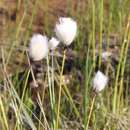mk
имиња во трошки


Eriophorum brachyantherum, the closed-sheath cotton-grass, short-anthered cotton-grass or northland cottonsedge, is a species that is a part of the Cyperaceae or sedge family.[1] It is commonly found in wet areas, such as bogs and cooler climate zones.
Eriophorum brachyantherum is a perennial monocot with 30–60 cm long stems, 1–2 cm flowers, and 2–4 cm fruit. The root balls are very thick with a fibrous root system.[1] The flower is a single, white, cotton ball-like, feathery flower. In the center of the flower there is an oval shaped fruit that contains short anthers.[1] The fruit is an achene that has scales and is surrounded by perianth bristles. The bristles are extended within the fruit and tend to be silky.[2] This plant grows in grass-like environments and blooms during the summer months of June, July, and August.[3]
The northland cottonsedge has a circumboreal distribution in North America, Europe, and Asia. In the United States it is primarily occurs in Alaska, though it has been recorded from Idaho and Washington as well.[4] In Canada it occurs natively almost country-wide (AB, BC, MB, NL, NT, NU, ON, QC, SK, YT). It prefers to grow in wet areas, and is commonly found in or near bogs, tundra, muskeg, and fens.[5]
Eriophorum brachyantherum can be found in water-saturated substrates with high organic matter content. Damp areas with poor drainage such as wet meadows, tundra landscapes, and flood plains are common occupancy areas for populations of this herb.[6] Muskeg swamps are also common environments where this plant is found because of the heavily saturated soil and high organic matter from partially dead vegetation and mosses that occupy the surrounding area. Northland cottonsedge is seldom seen distant from forest edges.[6]
Eriophorum brachyantherum flowers in the summertime. The central flowering stems of this plant are significantly taller than the leaves surrounding them. Both sexes are present on each floret of the terminal spike. There are 3 stamens with the anthers splitting longitudinally and 3 ovary carpels that are syncarpous. Each ovary consists of 3 stigmas and 1 ovule. The seed heads consist of white cotton-like fibers and are dispersed by the wind to spread the seeds.[7]
The stem and root of this plant were previously used as food by Native Americans, albeit very seldom. The Native Americans would boil the root or simply eat it raw, and for the stem they would store it or fry it in seal oil. The Yupik people used an extract from the leaves as a medical treatment for a variety of gastrointestinal problems.[8]
Eriophorum brachyantherum, the closed-sheath cotton-grass, short-anthered cotton-grass or northland cottonsedge, is a species that is a part of the Cyperaceae or sedge family. It is commonly found in wet areas, such as bogs and cooler climate zones.
Himmeävilla (Eriophorum brachyantherum, myös E. callithrix, E. opacum) on Euraasiassa ja Pohjois-Amerikassa kasvava ravinteisten pohjoisten soiden kasvi. Suomessa se on harvinainen ja luokiteltu vaarantuneeksi lajiksi.[1]
Himmeävilla on löyhästi mätästävä ja rönsytön. Sen varsi on 40–50 cm pitkä ja 1–1,5 mm paksu. Varren tyvitupet ovat harmahtavanruskeita. Varrella on kaksi väljähköä ja lavatonta, 3–4 cm leveää tuppea. Lehdet ovat puolet varren pituudesta, 0,5–1 mm leveitä ja kolmesärmäisiä tai liereitä. Kukinto on yksittäinen, varren kärjessä oleva tähkä. Läpikuultamattomat tähkäsuomut ovat noin viisi millimetriä pitkiä, puikeita, lyhytsuippuisia ja kärjestä tummanvihreänharmaita. Himmeävilla kukkii Suomessa kesä-heinäkuussa. Kukinnan jälkeen kukinnon kehäsukaset pitenevät paljon tähkää pidemmiksi kellanharmahtaviksi tai valkoisiksi karvoiksi. Karvojen pituus lopulta 1,5–2 cm ja ne muodostavat pumpulimaisen ja tasaiseksi leikatun näköisen tupsun.[2][3]
Himmeävillaa tavataan laajalla yhtenäisellä alueella Norjan, Ruotsin ja Suomen keski- ja pohjoisosista läpi Pohjois- ja Itä-Venäjän, ja edelleen Alaskaan, Kanadaan ja Yhdysvaltojen pohjoisosiin. Aasiassa levinneisyysalue ulottuu Siperian läpi eteläänpäin Mongoliaan ja Pohjois-Kiinaan saakka. Runsaimmin lajia tavataan Fennoskandiassa.[4] Suomessa himmeävillaa tavataan paikoitellen Lapissa ja Kainuussa. Lajia on aikaisemmin kasvanut myös pohjoisessa Keski-Suomessa, Pohjois-Savossa ja Pohjois-Karjalassa.[5]
Himmeävilla viihtyy ravinteisilla lettorämeillä ja -korvissa. Sitä tavataan myös soiden reunamilla ohutturpeisilla, lähteisillä paikoilla, rannoilla ja joskus ojissakin. Laji on kalkinsuosija. Suomessa himmeävilla on harvinaistunut soiden ojitusten ja metsien uudistamis- ja hoitotoimien takia.[2][3]
Himmeävilla (Eriophorum brachyantherum, myös E. callithrix, E. opacum) on Euraasiassa ja Pohjois-Amerikassa kasvava ravinteisten pohjoisten soiden kasvi. Suomessa se on harvinainen ja luokiteltu vaarantuneeksi lajiksi.
Myrull, Eriophorum brachyantherum, är ett halvgräs.
Denna art förväxlas ibland med tuvull, Eriophorum vaginatum, med vilken den även bildar hybrider.
Eriophorum brachyantherum là loài thực vật có hoa trong họ Cói. Loài này được Trautv. & C.A.Mey. mô tả khoa học đầu tiên năm 1856.[1]
Eriophorum brachyantherum là loài thực vật có hoa trong họ Cói. Loài này được Trautv. & C.A.Mey. mô tả khoa học đầu tiên năm 1856.